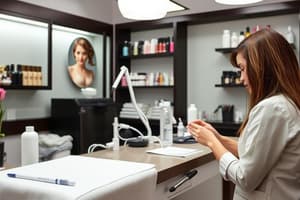Podcast
Questions and Answers
In what situation should a nail service not be performed?
In what situation should a nail service not be performed?
When a client's nail or skin is infected, inflamed, broken, or swollen
Name at least eight common nail disorders and describe their appearance.
Name at least eight common nail disorders and describe their appearance.
- Beau's lines: visible depressions running across the width of the natural nail plate. 2. Blue fingernails: nail bed is blue. 3. Bruised nail beds: dark purplish spot. 4. Discolored nails: nails that turn a variety of colors. 5. Eggshell nails: thin, white nail plates. 6. Hangnail: living skin around the nail plate splits and tears; possible dry skin or small cuts. 7. Koilonychia: concave shape that appears to be scooped out. 8. Leukonychia spots: white discolorations on the nail. 9. Melanonychia: black band within the nail plate extending from the base to the free edge. 10. Onychophagy: nails that have been chewed off. 11. Onychorrhexis: series of lengthwise ridges giving a rough appearance. 12. Plicatured nail: highly curved nail that folds under and back into the skin. 13. Ridges: vertical lines running down the length of the nail plate that cause uneven growth of the nails. 14. Splinter hemorrhage: blood that oxidized and turned brown or black, giving the appearance of a small splinter underneath the nail plate.
What conditions do fungal organisms favor for growth?
What conditions do fungal organisms favor for growth?
Warm, moist, and dark places (e.g., on feet inside shoes)
What is pseudomonas aeruginosa and why is it important to learn about it?
What is pseudomonas aeruginosa and why is it important to learn about it?
What is the most effective way to avoid transferring infections among your clients?
What is the most effective way to avoid transferring infections among your clients?
A cosmetologist can offer treatment advice for a client who has developed a nail infection.
A cosmetologist can offer treatment advice for a client who has developed a nail infection.
A cosmetologist can treat an ingrown toenail if there is no sign of pus discharge.
A cosmetologist can treat an ingrown toenail if there is no sign of pus discharge.
Name two common causes of onycholysis.
Name two common causes of onycholysis.
Flashcards are hidden until you start studying
Study Notes
Nail Service Guidelines
- Nail services should not be performed on clients with infected, inflamed, broken, or swollen nails or skin.
Common Nail Disorders
- Beau's lines: Visible depressions across the nail’s width.
- Blue fingernails: Characterized by a blue nail bed.
- Bruised nail beds: Present as a dark purplish spot.
- Discolored nails: Nails that show various color changes.
- Eggshell nails: Thin and fragile white nail plates.
- Hangnail: Split or torn living skin around the nail, often due to dryness or small cuts.
- Koilonychia: Nails with a concave shape, resembling a scoop.
- Leukonychia spots: White spots or discolorations on the nail.
- Melanonychia: Black band from base to free edge, sometimes covering the entire nail.
- Onychophagy: Nails that have been chewed down.
- Onychorrhexis: Series of rough, lengthwise ridges.
- Plicatured nail: Highly curved nail that folds back into the skin.
- Ridges: Vertical lines along the nail plate, indicating uneven growth.
- Splinter hemorrhage: Brown or black spots under the nail, resembling splinters, due to oxidized blood.
Fungal Growth Conditions
- Fungal organisms thrive in warm, moist, and dark environments, commonly found inside shoes on feet.
Pseudomonas Aeruginosa
- This bacteria can cause green, yellow, or black discoloration on the nail bed, indicating a rapid infection potential under favorable conditions.
Infection Control
- The best prevention against transferring infections among clients is thorough cleaning, disinfection, and sterilization of all tools and implements.
Client Treatment Restrictions
- Cosmetologists cannot offer treatment advice for nail infections; clients must be referred to a physician.
- Cosmetologists cannot treat ingrown toenails, even in the absence of pus; referral to a physician is necessary.
Causes of Onycholysis
- Onycholysis can result from physical injury, trauma, or allergic reactions affecting the nail bed.
Studying That Suits You
Use AI to generate personalized quizzes and flashcards to suit your learning preferences.




